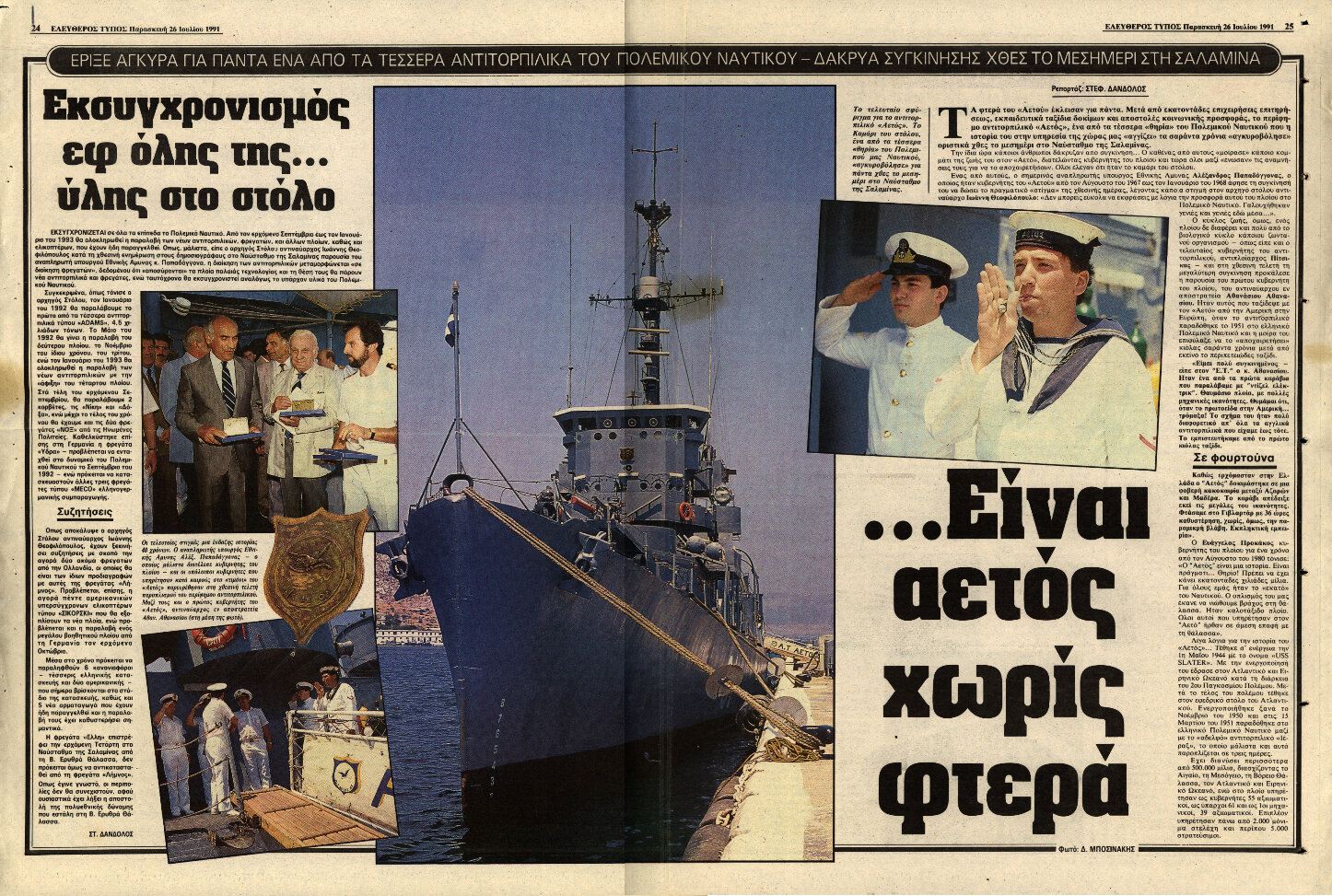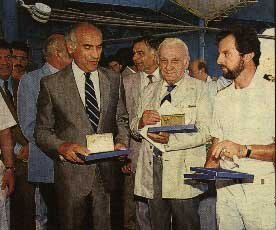24 Free Press (Eleftheros Typos) Friday 26 June 1991. (English translation appears below.)
One of four old destroyers of the Hellenic Navy cast anchor forever - Tears of emotion yesterday noon in Salamina
The Fleet is undergoing a major modernization program
The last moments of a heroic 40 year history. The deputy Minister of Defense (Vice-Admiral, Ret.) Alexandros Papadongonas (front row third from right) – who has served as one of the ship's commanding officers – and others who had served as commanding officers at the helm of "Aetos" over the years were present at yesterday's decommissioning ceremony of the storied ship. Among them was the first commanding officer of the ship Vice-Admiral, Ret. Athanassios Athanassiou (front row second from right)
The Navy is being modernized at every level. The acquisition and commissioning of new destroyers, frigates, other ships, and helicopters will take place from September 1991 to January 1993.
Yesterday, the Chief of the Fleet Vice-Admiral Ioannis Theofilopoulos held a press conference at the Salamis Navy Base in the presence of the Deputy Defense Minister Mr. Papadongonas. During this press conference he announced that the Destroyer Command will be renamed Frigate Command because old technology ships are being replaced by new frigates and destroyers as, concurrently, the presently commissioned Hellenic Navy ships and armaments will be modernized.
Specifically, the Chief of the Fleet emphasized that in January 1992 the first of four 4,500 ton "Adams" class destroyers will be transferred from the US Navy. In May of 1992 the second ship will be transferred followed by the third in the following September and the last one in January 1993. In September 1991 we will receive two new corvettes, "Niki" (Victory) and "Doxa" (Glory). Also, by the end of 1991 we will have received two "Knox" type frigates from the US Navy. Furthermore, the new frigate Hydra has been launched in Germany. Commissioning of this ship in the Hellenic Navy is expected by September 1992. Meanwhile three other MECO type frigates will be built in collaboration between Greek and German shipyards.
Discussion on other Decisions
In addition, Vice Admiral Theofilopoulos announced new negotiations towards the purchase of two more frigates from Holland that will be of the same class as HS Limnos. The new ships will be equipped with six new Sikorsky helicopters. Furthermore, within the next year the Hellenic Navy will receive six new gunboats four of which are being built in Greece and two in the USA. Also, construction has started on five delayed LSTs.
Finally, next Wednesday the frigate Elli will return to the Salamis Naval Base from the Red Sea. The frigate Limnos will not replace the Elli as planned because the multinational allied force's mission in the Red Sea has ended.
S. Dandolos (reporting)
… An eagle without wings
The last whistle call for the destroyer Aetos (Eagle). The pride of the fleet, one of the four "beasts" of our Hellenic Navy, cast anchor yesterday noon in the naval station of Salamina.
The wings of the Eagle1 closed for ever. After hundreds of reconnaissance missions, training cruises for our cadets, and public benefit missions, spanning for nearly forty years of service, the famous destroyer Eagle, one of the four "beasts2" of the Hellenic Navy, cast anchor for the last time yesterday noon in the naval station of Salamina.
At the same time some people shed tears of emotions... Every one of them had spent a part of their life on the Eagle, serving as her captain. Now all of them joined their memories together and came to bid farewell. They all agreed that she was the pride of the fleet.
One of them, the current substitute for the minister of National Defense Alexandros Papadogonas, who served as the Eagle's captain from August 1967 to January 1968, let his emotions show the real meaning of the day by saying to the Commander-in-Chief of the Fleet, Vice-Admiral Ioannis Theofilopoulos: "You cannot easily express with words the contribution of this ship to the Hellenic Navy. Generations and generations of our youth became men in this ship..."
However, the life cycle, of a ship is not much different than the biological cycle of a living being - as Commander Pitsikas, the last captain of the Eagle, said - and in yesterday's ceremony the presence of her first captain, retired Vice-Admiral Athanassios Athanassiou, caused the most emotions. He was the one who sailed the Eagle from America to Europe, when the destroyer was transferred to the Hellenic Navy in 1951. Now Vice-Admiral Athanassios Athanassiou's fate brought him to bid farewell forty years after that eventful trip.
"I am very moved" said Vice-Admiral Athanassiou to the Free Press. "She was one of the first diesel electric ships that we acquired. Magnificent ship, with many mechanical capabilities. I remember that, when I first saw her in America, I was terrified. Her design was very different from all the British origin destroyers we had until then. We had confidence in her from the very first voyage."
In the storm
"As we were coming to Greece Eagle was tested in a terrible storm between the Azores and Madeira. The ship proved her great capabilities. We reached Gibraltar 36 hours late but the ship did not suffer even the slightest damage. An astonishing experience."
Evangelos Prokakos, the ship's captain for a year from August 1980, pointed out: "The Eagle is a legend. It is indeed a...beast! It must have traveled hundreds of thousands of miles. For all of us it was the 911 (i.e. the ship to call for emergencies) of the Navy. Her weaponry made us feel like a rock in the sea. She was a very seaworthy ship. All of the people who served in the Eagle came into direct contact with the sea."
A few words about the history of the Eagle...
She became active on May 1st, 1944 under the name USS Slater. After her commissioning, she served in the Atlantic and Pacific Oceans during the Second World War. After the war was over, she was transferred to the Reserve Atlantic Fleet. She was reactivated in November of 1950 and on March 15th, 1951 was transferred to the Hellenic Navy together with her sister ship Ierax - Hawk which will also retire from the Hellenic Navy three days after Aetos-Eagle.
She has covered more than 500,000 miles in the Aegean, Mediterranean, the North Sea, the Atlantic, and the Pacific. Fifty five Greek officers have served as Aetos-Eagle's captain, 61 as her executive officers, and 39 as her chief engineering officers. Moreover, more than 2,000 career and 5,000 conscripted seamen served on her.
Photographs by D. Bosinakis
English Translation by: Tasos Anastahas and Nikos Athanassiou
Eagle is the literal translation of the ship's Greek name, Aetos.
The four DEs acquired by the Hellenic Navy were named after wild animals: Aetos-Eagle, Ierax-Hawk, Leon-Lion, Panthir-Panther. Throughout their long service in the Hellenic Navy they were known as "the beasts".
Continue to Return to the U.S.


